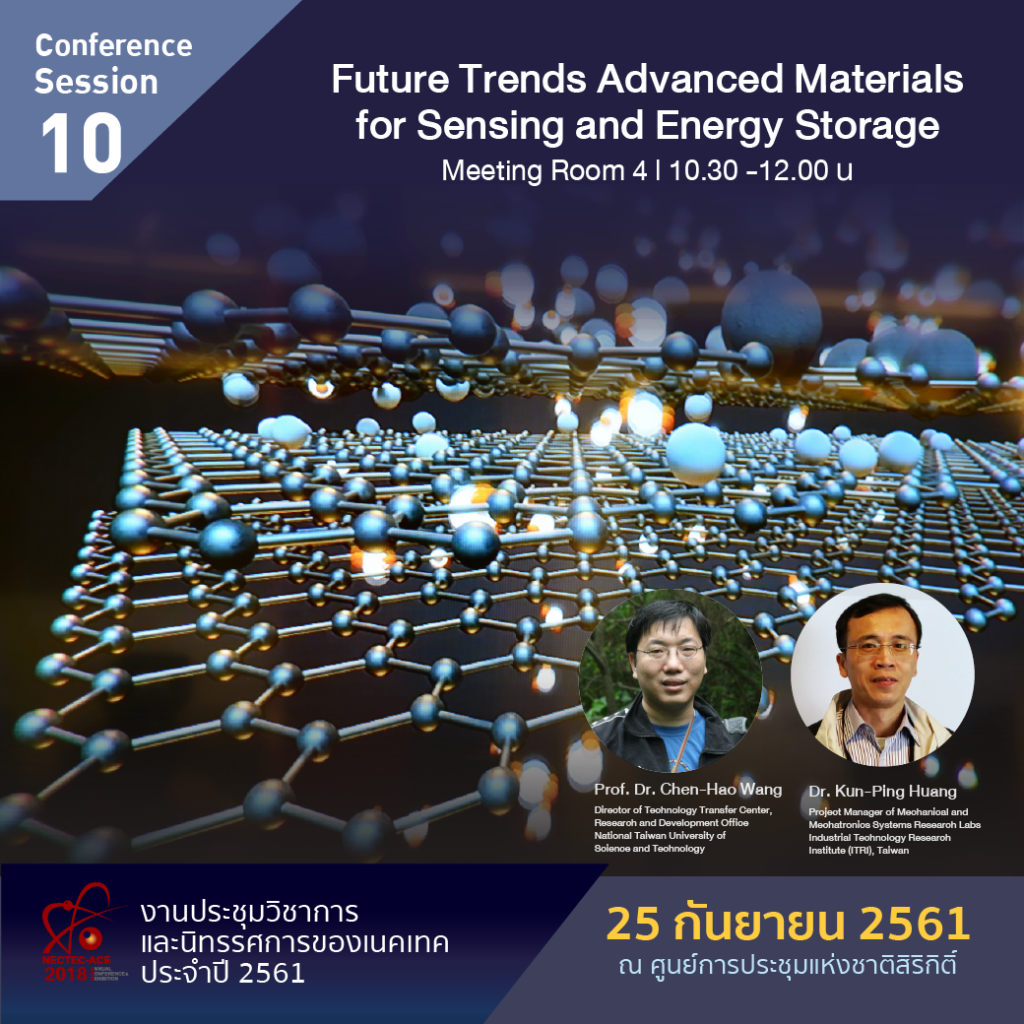หัวข้อ: Future Trends in Advanced Materials for Sensing and Energy Storage
ห้องสัมมนา: Meeting Room 4
เวลา: 10.30 - 12.00 น.

Based on innovative and functional nanomaterial process, recent developments in advanced materials have grown rapidly toward many demands in many fields of applications. This seminar covers international research collaborations and networks of recent interests.
The first talk covers development of high-voltage graphene nanowalls supercapacitor with the effectively matching pair of electrode materials and electrolytes. The binder-free, vertically grown graphene nanowalls (GNW) and nitrogen-doped GNW (NGNW) electrodes respectively provide good examples for extending the upper potential limit of a positive electrode of EDLCs.
The second talk discusses redox flow batteries, the storage battery technologies that offer the finest combination of capacity, cost, durability, and low environmental impact. In the near future, it will become a home storage battery that could benefit in supplying communities with 24-hour power, with no need to build additional connections to strained national electricity grids.
1st talk: High-Voltage Graphene Nanowalls Supercapacitor
Dr. Huang and his research group proposed a guideline, “choosing a matching pair of electrode materials and electrolytes”, to effectively extend the cell voltage of EDLCs according to three general strategies. Based on the new strategy proposed in their work, materials with an inert surface enable to tolerate a wider potential window in commercially available organic electrolytes in comparison with activated carbons (ACs) powder-coated electrodes, GNW/Ti and NGNW/Ti display a binder-free, vertical structure, favoring the penetration of electrolytes and electron transport in the whole graphene matrix. The oxygen-free, binder-free GNWs circumvent the issue of oxygen-functional group removal, which are inert to the irreversible oxidation of organic electrolytes, enlarging the upper limit of working potential window. The uniform N doping on the binder-free, vertical NGNWs significantly depresses the irreversible reduction of residual water and organic electrolyte at the negative potential end, further enlarging the working potential window. This newly designed asymmetric EDLC exhibits a cell voltage of 4 V, specific energy of 52 Wh kg−1 (ca. a device energy density of 13 Wh kg−1), and specific power of 8 kW kg−1 and ca. 100% retention after 10,000 cycles charge-discharge, reducing the series number of EDLCs to enlarge the module voltage and opening the possibility for directly combining EDLCs and LIBs in advanced applications.
2nd talk: Development of Highly Efficient Electrode for Vanadium Redox Flow Battery
The rapid growth of global economy and social development has considerably shifted the demand for electrical energy. To encounter this type of massive demand conventionally, to encourage nations worldwide to seek effective approaches to reduce fossil fuels that produce polluted emissions causing substantial environmental damages, to explored eco-friendly sources of energy, and also to enhance the efficiency of the current electrical grid infrastructure, the novel development of efficient energy storage systems is indeed needed and has been the primary focus of many researchers in the past decades. The goal is not only to satisfy the requirement for stable power but also to make up any shortfall between supply and demand of renewable energy sources and to match generation with load requirements. Accordingly, renewable energy sources have gained much attention due to their low environmental impact; however, the integration of renewable energy into the electrical grid is still limited due to fluctuations in efficiency, absence of main light source (night time), unpredictability (wind and wave power) with deviations in the global climate, and the requirement of being used in combination with energy storage devices. For the large-scale energy storage systems, it is significant to store energy during peak production and release it into the grid during peak demand. Among the available large-scale energy storage technologies, redox flow batteries (RFBs) are considerably the most promising candidate because of their highly efficient electrochemical energy storage and conversion devices where energy is stored and converted through chemical changes in species dissolved in the active electrolyte. Unlike those conventional secondary batteries, RFBs employ electroactive materials stored externally in separate liquid reservoirs and pumped to and from the power converting device when energy is being transferred. Therefore, the energy capacity and the power output scale up independently, with the former determined by the volume and concentration of the electrolyte and the latter depending on the electrode size. Furthermore, RFBs generally have a long service life, rapid response to load changes, deep discharge tolerance, design flexibility, and safety with low environmental impact. Henceforward, the VRFBs are affordable batteries that can harvest solar, wind, and wave energy and store them for future usage. This type of storage battery technologies has offered the finest combination of capacity, cost, durability, and low environmental impact. In the near future, it will become a home storage battery that could benefit in supplying communities with 24-hour power, with no need to build additional connections to strained national electricity grids.
Agenda
10.30 - 12.00 น.
- High-Voltage Graphene Nanowalls Supercapacitor by Dr. Kun-Ping Huang
- Development of Highly Efficient Electrode for Vanadium Redox Flow Battery by Prof. Dr. Chen-Hao Wang
speakers:
- Dr. Kun-Ping Huang
Project Manager of Mechanical and Mechatronics Systems Research Labs
Industrial Technology Research Institute (ITRI), Taiwan
ดาวน์โหลดไฟล์นำเสนอ - Prof. Dr. Chen-Hao Wang
Director of Technology Transfer Center, Research and Development Office
National Taiwan University of Science and Technology
ดาวน์โหลดไฟล์นำเสนอ
